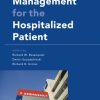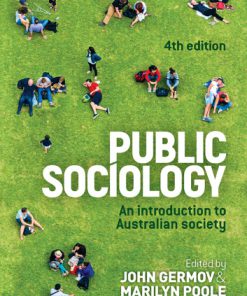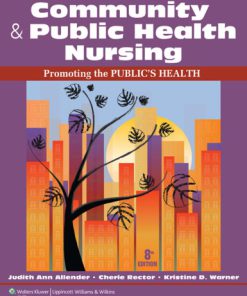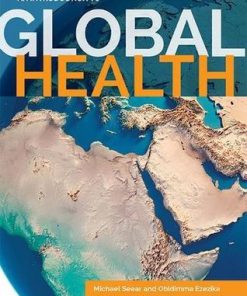An Introduction to Community and Public Health 9th Edition by James Mckenzie, Robert Pinger, Denise Seabert ISBN 9781284129847 1284129845
$50.00 Original price was: $50.00.$25.00Current price is: $25.00.
An Introduction to Community and Public Health 9th Edition by James Mckenzie, Robert Pinger, Denise Seabert – Ebook PDF Instant Download/Delivery: 9781284129847 ,1284129845
Full download An Introduction to Community and Public Health 9th Edition after payment
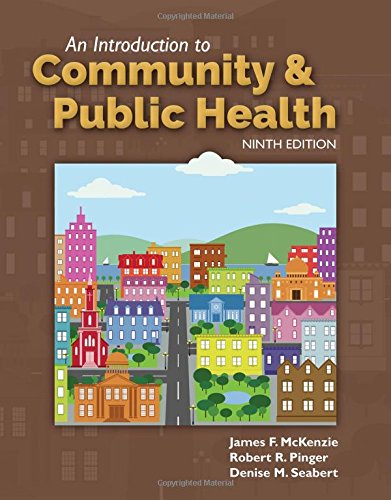
Product details:
ISBN 10: 1284129845
ISBN 13: 9781284129847
Author: James Mckenzie, Robert Pinger, Denise Seabert
An Introduction to Community and Public Health 9th Edition Table of contents:
Chapter 1 Community and Public Health: Yesterday, Today, and Tomorrow
Scenario
Introduction
Definitions
Factors That Affect the Health of a Community
A History of Community and Public Health
Earliest Civilizations
The Eighteenth Century
The Nineteenth Century
The Twentieth Century
The Twenty-First Century
Chapter Summary
Scenario: Analysis and Response
Chapter 2 Organizations that Help Shape Community and Public Health
Scenario
Introduction
Governmental Health Agencies
International Health Agencies
National Health Agencies
State Health Agencies
Local Health Departments
Whole School, Whole Community, Whole Child (WSCC) Model
Quasi-Governmental Health Organizations
The American Red Cross
Other Quasi-Governmental Organizations
Nongovernmental Health Agencies
Voluntary Health Agencies
Professional Health Organizations/Associations
Philanthropic Foundations
Service, Social, and Religious Organizations
Corporate Involvement in Community and Public Health
Chapter Summary
Scenario: Analysis and Response
Chapter 3 Epidemiology: The Study of Disease, Injury, and Death in the Community
Scenario
Introduction
Definition of Epidemiology
History of Epidemiology
The Importance of Rates
Incidence, Prevalence, and Attack Rates
Interpretation of Rates
Reporting of Births, Deaths, and Diseases
Standardized Measurements of Health Status of Populations
Mortality Statistics
Life Expectancy
Years of Potential Life Lost
Disability-Adjusted Life Years
Health-Adjusted Life Expectancy
Sources of Secondary Data
The U.S. Census
Vital Statistics Reports
Morbidity and Mortality Weekly Report
National Health Surveys
Epidemiological Studies
Descriptive Studies
Analytic Studies
Determining Causation
Chapter Summary
Scenario: Analysis and Response
Chapter 4 Communicable and Noncommunicable Diseases: Prevention and Control of Diseases and Health C
Scenario
Introduction
Classification of Diseases and Health Problems
Communicable versus Noncommunicable Diseases
Acute versus Chronic Diseases and Illnesses
Communicable Diseases
Chain of Infection
Modes of Transmission
Noncommunicable Diseases
Diseases of the Heart and Blood Vessels
Malignant Neoplasms (Cancer)
Other Noncommunicable Disease Problems
Prioritizing Prevention and Control Efforts
Leading Causes of Death
Years of Potential Life Lost
Economic Cost to Society
Prevention, Intervention, Control, and Eradication of Diseases
Levels of Prevention
Prevention of Communicable Diseases
Prevention of Noncommunicable Diseases
Chapter Summary
Scenario: Analysis and Response
Chapter 5 Community Organizing/Building and Health Promotion Programming
Scenario
Introduction
Community Organizing/Building
Need for Organizing Communities
Assumptions of Community Organizing
Community Organizing Methods
The Process of Community Organizing/Building
Recognizing the Issue
Gaining Entry into the Community
Organizing the People
Assessing the Community
Determining the Priorities and Setting Goals
Arriving at a Solution and Selecting Intervention Strategies
The Final Steps in the Community Organizing/Building Process: Implementing, Evaluating, Maintaining,
A Special Note about Community Organizing/Building
Health Promotion Programming
Basic Understanding of Program Planning
Creating a Health Promotion Program
Assessing the Needs of the Priority Population
Setting Appropriate Goals and Objectives
Creating an Intervention That Considers the Peculiarities of the Setting
Implementing the Intervention
Evaluating the Results
Chapter Summary
Scenario: Analysis and Response
Chapter 6 The School Health Program: A Component of Community and Public Health
Scenario
Introduction
Whole School, Whole Community, Whole Child: A Collaborative Approach to Learning and Health
The School Health Advisory Council
The School Nurse
The Teacher’s Role
The Need for School Health
Foundations of the School Health Program
School Health Policies
Policy Development
Policy Implementation
Policy Development Resources
Monitoring the Status of School Health Policy in the United States
Components of the Whole School, Whole Community, Whole Child Model
Administration and Organization
School Health Services
Healthy School Environment
School Health Education
Development of and Sources of Health Education Curricula
Counseling, Psychological, and Social Services
Physical Education and Physical Activity
Nutrition Environment and Services
Community Involvement
Family Engagement
Employee Wellness
Issues and Concerns Facing School Health
Lack of Support for School Health Initiatives
School Health Curriculum Challenges
School-Based Health Centers
Violence in Schools
Chapter Summary
Scenario: Analysis and Response
Unit Two The Nation’s Health
Chapter 7 Maternal, Infant, and Child Health
Scenario
Introduction
Family and Reproductive Health
Teenage Births
Family Planning
Maternal Health
Preconception and Prenatal Health Care
Infant Health
Infant Mortality
Improving Infant Health
Child Health
Childhood Mortality
Childhood Morbidity
Community Programs for Women, Infants, and Children
Maternal and Child Health Bureau
Women, Infants, and Children Program
Providing Health Insurance for Women, Infants, and Children
Providing Child Care
Other Advocates for Children
Chapter Summary
Scenario: Analysis and Response
Chapter 8 Adolescents, Young Adults, AND Adults
Scenario
Introduction
Adolescents and Young Adults
Demography
A Health Profile
Community and Public Health Strategies for Improving the Health of Adolescents and Young Adults
Adults
A Health Profile
Community and Public Health Strategies for Improving the Health of Adults
Chapter Summary
Scenario: Analysis and Response
Chapter 9 Older adults
Scenario
Introduction
Definitions
Myths Surrounding Aging
Demography of Aging
Size and Growth of the Older Adult Population in the United States
Factors That Affect Population Size and Age
Other Demographic Variables Affecting Older Adults
A Health Profile of Older Adults
Mortality
Morbidity
Health Behaviors and Lifestyle Choices
Mistreatment of Older Adults
Instrumental Needs of Older Adults
Income
Housing
Personal Care
Health Care
Transportation
Community Facilities and Services
Chapter Summary
Scenario: Analysis and Response
Chapter 10 Community and Public Health and Racial/Ethnic Populations
Scenario
Introduction
Racial and Ethnic Classifications
Health Data Sources and Their Limitations
Americans of Hispanic Origin Overview and Leading Causes of Death
African Americans Overview and Leading Causes of Death
Asian Americans Overview and Leading Causes of Death
American Indians and Alaska Natives Overview and Leading Causes of Death
U.S. Government, Native Americans, and the Provision of Health Care
Indian Health Service
Immigrant and Refugee Health
Minority Health and Health Disparities
Infant Mortality
Cancer Screening and Management
Cardiovascular Diseases
Diabetes
HIV Infection/AIDS
Child and Adult Immunization Rates
Social Determinants of Health and Racial and Ethnic Disparities in Health
Equity in Minority Health
Cultural Competence
Empowering the Self and the Community
Chapter Summary
Scenario: Analysis and Response
Chapter 11 Community Mental Health
Scenario
Introduction
Definitions
Classification of Mental Disorders
Causes of Mental Disorders
History of Mental Health Care in the United States
Mental Health Care before World War II
Mental Health Care after World War II
Mental Health Care Concerns in the United States Today
Serious Mental Illness in People Who Are Homeless
Mental Illness and Violence
The New Asylums: Mental Health Care in Jails and Prisons
Meeting the Needs of People with Mental Illness
Government Policies and Mental Health Care
The Affordable Care Act
Chapter Summary
Scenario: Analysis and Response
Chapter 12 Alcohol, Tobacco, and Other Drugs: A Community Concern
Scenario
Introduction
Scope of the Current Drug Problem in the United States
Definitions
Factors that Contribute to Alcohol, Tobacco, and Other Drug Abuse
Inherited Risk Factors
Environmental Risk Factors
Types of Drugs Abused and Resulting Problems
Legal Drugs
Controlled Substances and Illicit (Illegal) Drugs
Prevention and Control of Drug Abuse
Levels of Prevention
Elements of Prevention
Governmental Drug Prevention and Control Agencies and Programs
Nongovernmental Drug Prevention and Control Agencies and Programs
Chapter Summary
Scenario: Analysis and Response
Chapter 13 Health care Delivery in the united states
Scenario
Introduction
A Brief History of Health Care Delivery in the United States
Health Care System: Structure
The Spectrum of Health Care Delivery
Types of Health Care Providers
Health Care Facilities and Their Accreditation
Health Care System: Function
Understanding the Structure of the Health Care System
Health Insurance
Managed Care
Other Arrangements for Delivering Health Care
Health Care Reform in the United States
Consumer-Directed Health Plans
Health Care Reform in the U.S: How Did It Happen, Where Is It Headed?
Chapter Summary
Scenario: Analysis and Response
Unit Three Environmental Health and Safety
Chapter 14 Community and Public Health and the Environment
Scenario
Introduction
The Air We Breathe
Outdoor Air Pollution
Regulation of Outdoor Air Quality
Indoor Air Pollutants
Protecting Indoor Air
The Water We Use
Sources of Water
Sources of Water Pollution
Ensuring the Safety of Our Water
Regulating Water Quality
The Food We Eat
Foodborne Disease Outbreaks
Growing, Processing, and Distributing Our Food Safely
Regulating Food Safety
The Place We Live
Solid and Hazardous Waste
Managing Our Solid Waste
Managing Our Hazardous Waste
Controlling Vectorborne Diseases
Natural Hazards
Radiation
Radiation from Natural Sources
Natural Environmental Events
Complex Disasters
Radiation from Human-Made Sources
Psychological and Sociological Hazards
Population Growth
Preparedness and Response
Chapter Summary
Scenario: Analysis and Response
Chapter 15 Injuries as a Community and Public Health Problem
Scenario
Introduction
Definitions
Cost of Injuries to Society
Unintentional Injuries
Types of Unintentional Injuries
Epidemiology of Unintentional Injuries
Prevention through Epidemiology
Community Approaches to the Prevention of Unintentional Injuries
Intentional Injuries
Types of Intentional Injuries
Epidemiology of Intentional Injuries
Violence in Our Society and Resources for Prevention
Chapter Summary
Scenario: Analysis and Response
Chapter 16 Safety and Health in the Workplace
Scenario
Introduction
Scope of the Problem
Importance of Occupational Safety and Health to the Community
History of Occupational Safety and Health Problems
Occupational Safety and Health in the United States Before 1970
Occupational Safety and Health Act of 1970
Prevalence of Occupational Injuries, Diseases, and Deaths
Overview of Recent Trends in Workplace Injuries and Illnesses
Unintentional Injuries in the Workplace
Prevention and Control of Unintentional Injuries in the Workplace
Workplace Violence: Intentional Workplace Injuries
Occupational Illnesses and Disorders
Resources for Preventing Workplace Injuries and Illnesses
Occupational Safety and Health Protection Professionals
Worksite Safety, Health, and Wellness Promotion Programs
Chapter Summary
Scenario: Analysis and Response
Glossary
Index
People also search for An Introduction to Community and Public Health 9th Edition:
mckenzie’s an introduction to community & public health 10th edition
mckenzie’s an introduction to community & public health pdf
mckenzie’s an introduction to community & public health free pdf
an introduction to community & public health 9th edition
Tags:
James Mckenzie,Robert Pinger,Denise Seabert,Community,Public Health
You may also like…
Engineering - Electrical & Electronic Engineering
Politics & Philosophy - Social Sciences
Public sociology an introduction to Australian society Germov
Medicine
Community and public health nursing promoting the public s health Allender 1609136888 9781609136888
Politics & Philosophy - Social Sciences
dictionaries & phrasebooks
Physics - General Courses
An Introduction to Physical Science 15th Edition James Shipman



